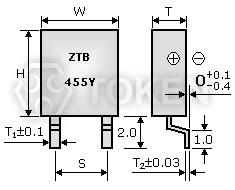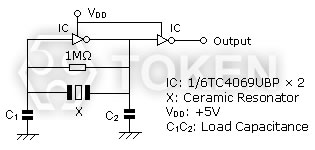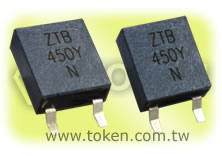Surface Mountable Resonators 375 - 1250 KHz (ZTBY)
KHz Surface Mountable Resonators (ZTBY) Introduction
Token formed leads surface mountable resonator is compatible to Murata resonator CSBF.
Token manufactures a broad range of high quality Ceramic Resonators covering both the KHz and Mhz frequency ranges and a full range of industry standard Through Hole and Surface Mount resonators both with and without internal capacitors. The high quality and extensive coverage of this product line allows optimum design of almost any oscillating circuit.
The surface mountable Ceramic resonators (ZTBY) is one of (ZTB) device series with the frequency range of 375 kHz to 1,250 kHz. Initial frequency tolerance is ± 0.5% which compares very favorably to the norminal ±2% ~ ±3% requirements of one chip microprocessors. Stability and Aging Tolerance narrows to ± 0.3%. The (ZTBY) Resonator provides reliable start up and stable oscillation in microprocessor circuits across a wide variety of applications.
The (ZTBY) Ceramic resonators stand between quartz crystal oscillators and LC/RC oscillators in regard to accuracy but are considerably smaller, require no adjustments, have improved start-up times, and are low in cost. The (ZTBY) oscillation is dependent upon mechanical resonance associated with their piezoelectric crystalline structure and utilizes the area vibration mode of the piezoelectric element.
Token (ZTBY) resonators conform to the RoHS directive. Application of specific designs also available including different tighter tolerances specification adjusted to frequency requirements. Please contact our sales for more information.
Download complete datasheet KHz Surface Mountable Resonators (ZTBY) PDF.
Dimensions (Unit: mm Tolerance: ±0.3mm) (ZTBY)
 Surface Mountable KHz (ZTBY) Dimensions |
|
Technical Characteristics (ZTBY)
| Part Number |
Frequency Accuracy (at 25°C) |
Resonant Impedance (Ω) |
Stability in Temperature (-20°C ~ +80°C) (%) |
Aging For 10 Years (%) |
Load Capacitance (pF) |
|
| C1 | C2 | |||||
| ZTB375 ~ 429Y | ±2kHz | ≤20 | ±0.3 | ±0.3 | 120 | 470 |
| ZTB430 ~ 509Y | ±2kHz | ≤20 | ±0.3 | ±0.3 | 100 | 100 |
| ZTB510 ~ 699Y | ±2kHz | ≤30 | ±0.3 | ±0.3 | 100 | 100 |
| ZTB700 ~ 999Y | ±0.5% | ≤70 | ±0.3 | ±0.3 | 100 | 100 |
| ZTB1000 ~ 1250Y | ±0.5% | ≤100 | ±0.3 | ±0.3 | 100 | 100 |
Resonator Selection - Test Circuit for MOS IC (ZTBY)

(ZTBY) Test Circuit for MOS IC
Loading Capacitor (C1 & C2)
The stability of the oscillation circuit is mainly determined by the C1 & C2 values. If the load capacitance is too small, unstable oscillation will occur because of oscillation waveform distortion. If too high, a stop in oscillation can be expected. When comparing the same IC, oscillation circuits with lower frequencies require higher capacitance.
Feedback Resistor (R = 1MΩ):
A Feedback Resistor is used to determine the oscillation circuit bias. The feedback resistance will contribute to instability if it is too large by reducing feedback. Conversely, if it is too small, increases in current will be realized thereby reducing gain. Recent developments in IC design allows for the integration of the feedback resistor in many cases.
Token Engineers can help with the circuit design if needed.
Resonator Optimization - IC Evaluations (ZTBY)
Tolerance is determined by the design of the resonator. However stability and correlation is determined by the IC evaluation. The microcontroller is evaluated with the ceramic resonators to determine the best possible circuit conditions to achieve stability and stable oscillation.
In addition, frequency correlation is measured to meet the tight initial frequency tolerance required. For the tight tolerance resonators the IC evaluation must be completed on the final circuit board layout. The final circuit boards provide the most accurate measurement of the frequency correlation.
This measurement will account for the effects of stray capacitance on the oscillation frequency. Once the correlation is determined the frequency of the resonator is adjusted to compensate for the correlation.
Order Codes (ZTBY)
| ZTB | 455 | Y | P | |||||||||
 |  |  |  | |||||||||
|
|
|
|
|||||||||
